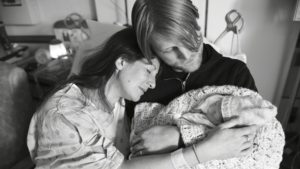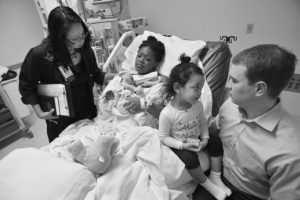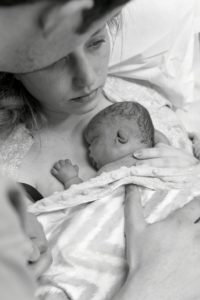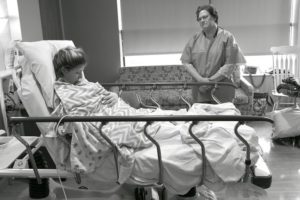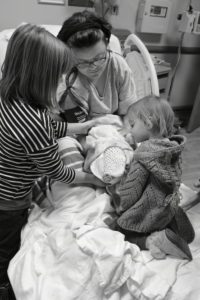For grieving families, the photos preserve the only memories they have of their child.
FEBRUARY 18, 2020 SHARA ZHANG
Since 1997, Todd Hochberg has been going to hospitals to photograph families after the death of a baby. These requests come at all times of day and night—more often at night, it seems, when it is a stillbirth. If he can, Hochberg will be there for the birth itself, and then in the emotional hours after as parents see and hold and even bathe their dead child while saying goodbye.
For parents, these photographs document one of the worst days of their life. But they also represent the few cherished memories they will ever have of their child. Hospitals used to whisk stillborn babies away from their parents, but they now recognize the importance of memories in grieving. Many offer photography, along with mementos such as footprints and locks of hair. Organizations such as Now I Lay Me Down to Sleep also have a network of volunteer photographers around the country.
Stillbirth affects about one in 100 pregnancies in the United States, which means that about 24,000 babies are stillborn in the U.S. every year. The cause is often unknown. Hochberg has photographed 500 to 600 families, including those whose infant died shortly after birth as well as those who lost an older child. He presents each family with an album with dozens of photos, sometimes as many as 130.
In the early 2000s, Hochberg left a corporate photography job to pursue what he calls “bereavement photography” full-time. He doesn’t charge the families. Some of the hospitals he works with have found grants to fund his work. Otherwise, he relies on donations. “It’s nowhere near what I made as a corporate photographer,” he says. “It’s certainly my life’s work at this point. I don’t see myself doing anything else.”
A transcript of our conversation follows. It has been condensed and lightly edited for clarity.
Sarah Zhang: There’s a lot of discomfort around death and dead bodies in our culture. You’ve been photographing families with their dead children for more than 20 years now. Has it changed how you feel about death?
Todd Hochberg: For certain. My first experience with a stillbirth, I was there in the room when Mom delivered. It was like the first time I had witnessed an open surgery with a lot of blood—the odors of the chemicals as well as the blood and wound. This very small and very premature baby had somewhat translucent skin. And it was a bit disarming, but I caught myself. I took some breaths and I went with it. My fear and my anxiety vanished when I saw that baby in Mom’s arms, as she cuddled and was connecting with this baby outside the womb.
Zhang: How did you get into bereavement photography?
Hochberg: I had been working in health care as a medical photographer and corporate photographer for a large health-care system in Chicago. The hospital needed pictures of surgical procedures as well as for evidentiary purposes. And I was looking for something a little more meaningful in my work. I made a friend who was a chaplain who worked with these families whose babies died at birth or shortly thereafter. And I had been a collector of antique Victorian photographs, these memorial images in Victorian times with children. I’d go to flea markets and antique shows and they spoke to me somehow.
Zhang: I’ve seen these Victorian photographs periodically go viral on social media, and they’re usually described as “creepy” and “unsettling.” What spoke to you in these photographs?
Hochberg: The grief was very present for me. They were largely portraits of parents holding their babies. My intention, when I thought of doing this work, was to do a portrait. What I discovered was something very different: I wanted to tell the story of these babies and their parents and their experience.
Zhang: When I’ve talked with parents who have had a stillbirth, they talk about how they just have so few memories. The blanket, the hat their child wore—these small things really come to mean a lot. Do you see your photographs as helping these families document the few memories they do have?
Hochberg: They have so little. The photographs are one more thing to help them bond and grieve more completely. They affirm their baby’s life, validate the feelings they’ve had. There could be many years of hopes and dreams for this baby’s existence, and to not have evidence—I use the term touchstones. The photographs become touchstones for a family’s own experience and their own feelings.
I’ve been in touch with families from upwards of 20 years hence. When they have an anniversary, they’ll send me an email telling me how much these pictures are still helpful to them. And the siblings of these babies are upwards of 20 years old or 15 years old. They still look at them.
Zhang: How do you approach photographing these babies, especially cases when they are very premature?
Hochberg: I don’t shy away from the reality of what’s there. And I don’t retouch anything, meaning take away scar tissue or what have you. But I will photograph in such a way, for some of the pictures at least, that is kinder to the anomalies or the difficult presentation. I photograph in black-and-white. That makes softer the discoloration that often happens. There could be skin peeling or maceration. But I’ll photograph in such a manner to be kinder. I’m there to photograph the story and the family’s connection.
I have a particular photograph that speaks to that, where the mother is holding this baby in the palm of her hand. Very young. It had spina bifida. I’m photographing at an angle below her. I’m on my knees, which I often do because I’m interested in seeing parents’ faces. There’s more intimacy in that. She holds this baby very close to her face, and she’s examining and tentatively looking over this baby. Her love and her grief are so present. I always try to photograph the babies in the context of being held, as opposed to lying in the bed or the warmer.
Zhang: Is there a particular photograph or family that has stuck with you?
Hochberg: I remember parents who had twins and one was stillborn. They knew he wasn’t going to survive delivery. It was a twin-to-twin transfusion. The other twin was in the NICU and Mom was in recovery. Dad decided he’s going to carry this stillborn baby to visit his twin in the NICU. He wanted his two sons together.
Zhang: What do parents usually do with your photographs? Do they keep them private or share them?
Hochberg: It varies. I’ve been in people’s homes a few months later, and I’ve seen some of my images hanging on the wall and on the mantle. I have families, proud moms who post on their Facebook pages. Some will keep them very private and just share between themselves. Parents might want to have them in their home but might not want to look at them for a couple years, a month. In one case, it was two years, and I got a call or an email from a mom that said she’s finally ready to see them.
Zhang: On your website, you write that “these photographs may be difficult for some people to view.” Have you had people who were angry or upset by your photographs? Why did you feel it was necessary to say this to viewers?
Hochberg: I was aware early on, it wasn’t very present in the culture. Everywhere I went, if I talked about it to people and friends, there is this aghastness. Their faces turn red. And then they listen to me and I describe the benefits to parents. It’s not a voyeuristic thing. There isn’t one person I’ve talked to who hasn’t said, “Oh, yeah, my mother had that baby” or “my cousin’s uncle” or “My best friend’s sister had a stillbirth.” There’s all these stories that come out when people start talking.
Zhang: It sounds like the photographs have two different purposes. One is for the parents themselves. But as parents have shared them and your work has gained more attention, they have also opened up a conversation about stillbirth. Was the second purpose always on your mind, or was it something that you noticed later?
Hochberg: I noticed it the second year I was doing the work. The chaplain I mentioned was a mentor to me, along with a nurse bereavement coordinator at the same hospital. They felt like, Other caregivers need to see what you’re doing. It wasn’t my idea. My intent then became, yes, help these parents first, but then also indirectly, through making these pictures for parents, by them showing their pictures to their friends and their neighbors and family members. It helped to change things a little bit …
Do you want to hear a quote from a parent?
Zhang: What is the quote?
Hochberg: This is one of the families I’ve photographed:
You have brought our son Jeremiah to life, giving him personality and a role of his own. In each record of our brief time together, you’ve captured the beauty of our son, his thick hair, his soft face and hands, his cuddly body. You’ve captured every nuance of emotion we experienced, things we didn’t even realize we were feeling. You have allowed us to experience it all again, every twist of the gut, every heartache, every proud moment, and especially the love. We value each feeling. You have validated our role in the experience by enabling us to share with our family and friends an important part of ourselves, a tale which could not be told adequately with words or even tears. You’ve captured the transformation that took place in our lives and hearts that night. We are not the same people we were before we met Jeremiah.
We want to hear what you think about this article. Submit a letter to the editor or write to letters@theatlantic.com.

